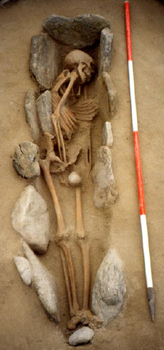Scottish Archaeological Internet Reports (SAIR)
Society of Antiquaries of Scotland, 2012. (updated 2023) https://doi.org/10.5284/1017938. How to cite using this DOI
Data copyright © Society of Antiquaries of Scotland unless otherwise stated
This work is licensed under the ADS Terms of Use and Access.
Primary contact
Society of Antiquaries of Scotland
National Museums Scotland
Chambers Street
Edinburgh
EH1 1JF
Scotland
Resource identifiers
- ADS Collection: 310
- DOI:https://doi.org/10.5284/1017938
- How to cite using this DOI
Introduction

Scottish Archaeological Internet Reports (SAIR) is an Open Access publication which was established in 2000 by a consortium comprising the Society of Antiquaries of Scotland, Historic Scotland and the Council for British Archaeology. Its purpose is to publish freely accessible but fully peer reviewed information more suited to an electronic format than a traditional print journal.
SAIR is a fully peer-reviewed Society of Antiquaries of Scotland publication and is edited to the same standard as our books and national journal, the Proceedings of the Society of Antiquaries of Scotland. Image-rich and data-rich projects are handled easily within the SAIR format. In the future, the Society will continue to explore new technologies and develop SAIR to ensure that it is fit for purpose. In this way, SAIR will continue to contribute to the dissemination of quality free information on Scotland's rich archaeological heritage.
Publish in SAIR
SAIR is intended to publish papers which particularly benefit from electronic publishing: those which are longer than 20,000 words, which have many illustrations (particularly colour illustrations), which have many or very long tables, and those which include lengthy specialist sections. Only papers of the highest standard will be accepted for publication in SAIR. All submissions are subject to peer review by at least two independent referees.
SAIR is published by the Society of Antiquaries of Scotland using an Open Access funding model that requires all submissions to include full financial support, for example through Historic Scotland or other grants or through developer funding.
Notes for contributors and submissions sheets are available. Questions about SAIR should be directed to the Managing Editor, Adela Rauchova.
History of SAIR
In 1999, the original consortium of the Society of Antiquaries of Scotland, Historic Scotland and the Council for British Archaeology along with the Royal Commission on Ancient and Historical Monuments of Scotland and the Archaeology Data Service established SAIR to address the changing needs of archaeological publication. Full excavation reports are costly to print and local and regional journals often did not have the necessary space to keep up with the volume of archaeological information being produced. SAIR was intended to provide a new, lower-cost publication outlet for detailed archaeological reports. Over time, SAIR has evolved to include the publication of many different types of projects, such as large-scale surveys, gazetteers and conference proceedings.
The Council for British Archaeology hosted SAIR on its servers until 2012 when, due to changes in circumstances at the Council for British Archaeology and a need to ensure the material is archived for the future, the Society decided to move the papers and the SAIR website to the Archaeology Data Service. This required a minor change to the format of the material being archived moving from PDF to PDF/A, which provides much greater security and stability for current and future access to this important material. The Society also began ascribing Digital Object Identifiers to reports in the same year.
Using the SAIR archive
The List of Volumes provides a full list of those volumes which are part of the archive, allowing users to order them by 'Volume' and 'Author'. SAIR volumes can also be searched and viewed in the ADS Library.







